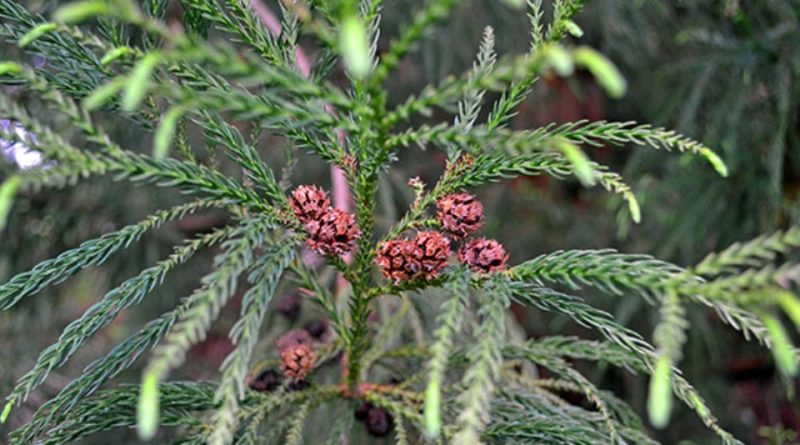Cryptomeria japonica
Cryptomeria japonica
Cryptomeria japonica (Cryptomeria japonica (Thunb. Ex L.f.) D.Don, 1841) is a plant belonging to the Cupressaceae family.
Systematics –
From a systematic point of view it belongs to the Domain Eukaryota, Kingdom Plantae, Subarign Tracheobionta, Superdivisione Spermatophyta, Division Pinophyta, Classe Pinopsida, Order Pinales, Family Cupressaceae and then to the Genus Cryptomeria and to the Specie C. japonica.
Etymology –
The term Cryptomeria comes from the Greek κρυπτός kryptós, hidden and μηρΰομαι merýomai, contract, tighten together: for the leaves tightly wrapped to hide the branches. The specific japonica epithet refers to its origin.
Geographic Distribution and Habitat –
Cryptomeria japonica is a tree native to the original plant islands of Kyushu and Honshu in Japan and of the southeastern China, where it can reach 40 meters in height. This species was introduced in Europe around the second half of the nineteenth century where it was used as an ornamental plant in parks and gardens.
Description –
Cryptomeria japonica is a tree up to 40 meters tall with a pyramidal crown, inhomogeneous and rounded at the top. The trunk is straight, stocky, with brown-reddish rind, longitudinally weakened, then furrowed, which is leafed through long gray plates. The leaves are persistent and are curled needles inwards, 1-2 cm long, inserted in a spiral; in winter they take on a brownish color.
The male cones are ovoid, yellow, placed at the apex of the terminal twigs and about 3 mm long; the female ones are terminal, spherical, slightly larger and greenish in color. After pollination they become about 2 cm galbuli, with the central axis sometimes extended beyond the scales in a young vegetative shoot. The scales are adorned with thick sculptures. When the galbulo reaches maturity it opens, dropping the seeds and persists on the tree for several months.
Cultivation –
Cryptomeria japonica is a species that prefers a hilly or mountainous habitat, preferring a temperate humid climate and fertile and deep, non-calcareous soils, with high environmental humidity and warm season mitigated by frequent precipitation; is a plant that adapts to any exposure: from full sun to shade and therefore lends itself to very dense plants. It is multiplied both by spring sowing and by agamic at the end of summer by cuttings, for 4-5 years old subjects are used for transplanting with about 4000-4500 plants / ha. It is used in wood and ruled arboriculture, thanks to the rapid vegetative growth, to high forest, with cycles of 35-40 years. For the details of the cultivation technique the following sheet can be consulted.
Uses and Traditions –
Cryptomeria japonica is considered a sacred tree in the places of origin and, for this reason, it is often planted near the temples.
The plants of this genus provide vulgar wood species commercially known as cedar (or red cedar). Depending on the species, we speak of Japanese red cedar for Cryptomeria japonica and Chinese cedar for Cryptomeria japonica var. sinensis. The wood is fragrant and fairly light (thickness 0.40 from dry), with reddish-pink color, tender, homogeneous and very durable; it is a wood particularly resistant to rotting and decomposition processes and, also for this reason, it is used for the manufacture of furniture.
In Japan it is widely used in wooden constructions and for the realization of dividing panels inside houses.
Its use as an ornamental plant is also linked to the property of changing the color of the leaves in the winter season, turning towards red-rust or bronzed shades; its dwarf cultivars are used to create rocky or potted gardens on the terraces.
Preparation Mode –
Cryptomeria japonica has no particular uses of food or therapeutic nature.
Guido Bissanti
Sources
– Acta Plantarum – Flora of the Italian Regions.
– Wikipedia, the free encyclopedia.
– Treben M., 2000. Health from the Pharmacy of the Lord, Advice and experience with medicinal herbs, Ennsthaler Publisher
– Pignatti S., 1982. Flora of Italy, Edagricole, Bologna.
– Conti F., Abbate G., Alessandrini A., Blasi C. (edited by), 2005. An annotated checklist of the Italian vascular flora, Palombi Editore.
Warning: Pharmaceutical applications and alimurgical uses are indicated for informational purposes only and do not in any way represent a medical prescription; there is therefore no liability for their use for curative, aesthetic or food purposes.


